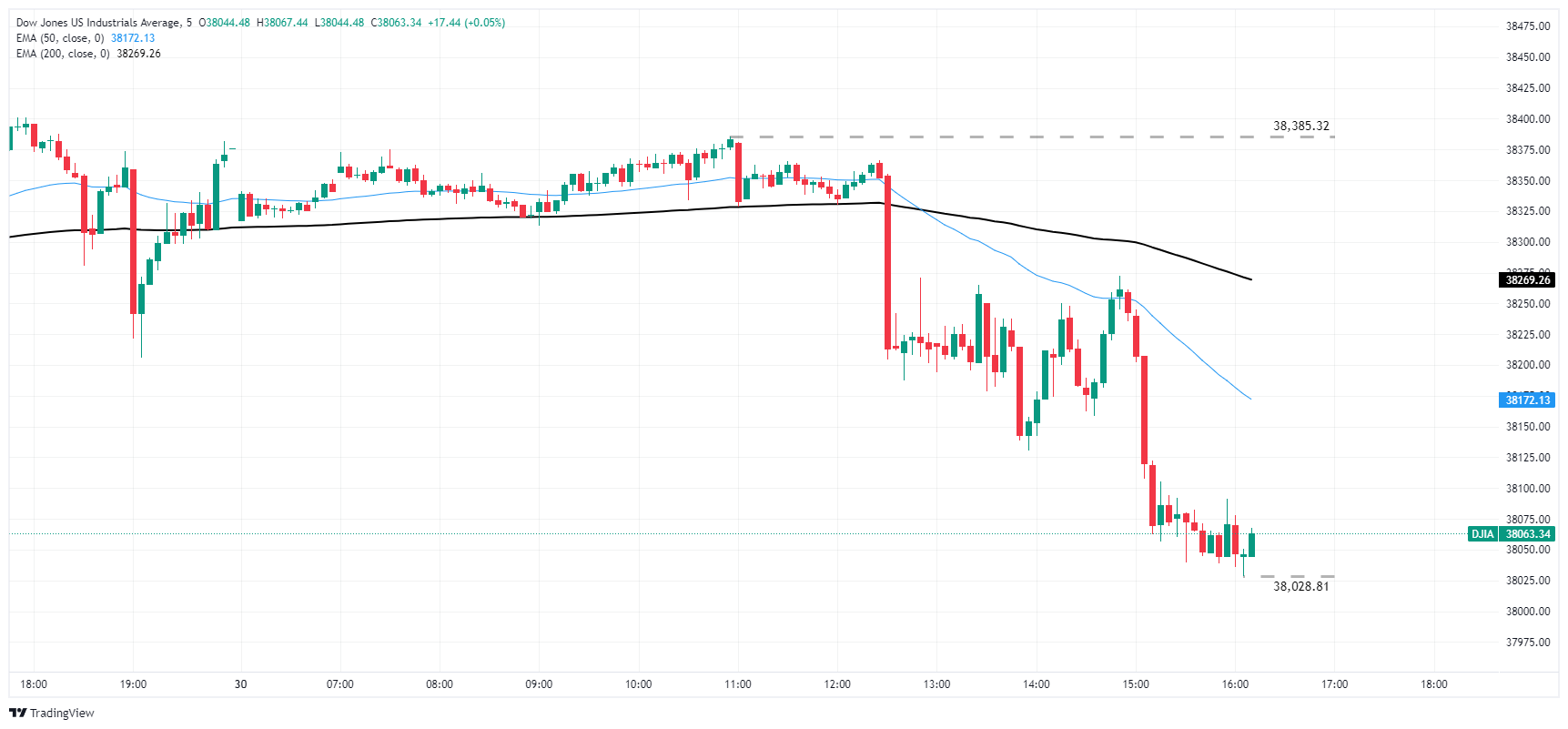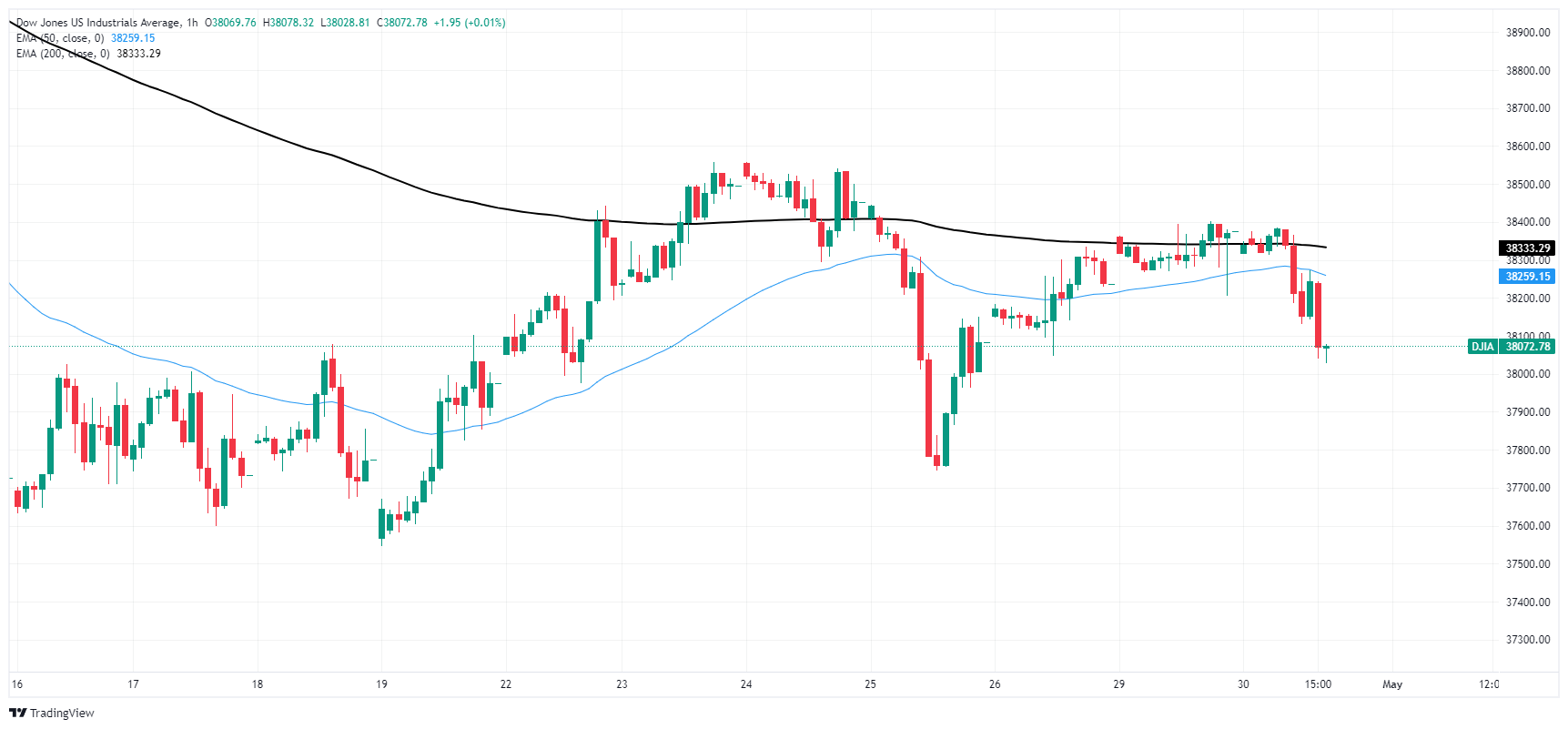- Analiza
- Novosti i instrumenti
- Vesti sa tržišta
- Dow Jones Industrial Average declines as risk appetite sours on Tuesday
Dow Jones Industrial Average declines as risk appetite sours on Tuesday
- Dow Jones tumbles as inflation concerns return to cloud rate cut hopes.
- US wage pressures increased, driving fresh inflation fears.
- Dow Jones backslides 300 points, at risk of falling below 38,000.
The Dow Jones Industrial Average (DJIA) declined alongside the other major US equity indexes as risk aversion strikes again just ahead of Wednesday’s latest Federal Reserve (Fed) rate call. The Fed’s two-day rate decision meetings started today, and investors are balking as the Fed kicks off rate discussions with a fresh batch of data suggesting inflation remains a sticky problem for the US.
US wage pressures and housing costs remain inflation risk
The US Employment Cost Index for the first quarter rose 1.2% QoQ, accelerating from the forecast uptick to 1.0% and the previous quarter’s 0.9%. The US S&P/Case-Shiller Home Price Indices for the year ended February rose 7.3%, above the forecast 6.7% and accelerating from the previous period’s 6.6%.
The Chicago Purchasing Managers Index (PMI) in April also fell to nearly a two-year low of 37.9, sharply lower than the forecast 44.9 and the previous month’s 41.4. The Consumer Board’s Consumer Confidence Index also declined to its lowest reading since July of 2022, falling to 97.0 from the previous month’s 103.1 (revised down from 104.7).
Read more: US CB Consumer Confidence declines to 97.0 in April
With housing inflation and wage growth continuing to outrun forecasts and expectations, hopes for near-term rate cuts from the Fed are evaporating, knocking risk appetite down at the knees. The Fed’s latest rate call is slated for 18:00 GMT on Wednesday, followed by a press conference at 18:30 and headed by Fed Chair Jerome Powell.
Dow Jones news
Market hopes for 2024 rate cuts have fallen steeply in the first half of the year. Investors kicked off January expecting around six rate cuts from the Fed through the year, and Tuesday’s inflation figures have knocked rate cut expectations all the way down to a single 25-basis-point cut in 2024. Markets now see a 51% chance of no rate cut in September, making November the current market favorite bet for a first rate trim.
Nearly all of the securities that make up the Dow Jones are in the red on Tuesday, with the only notable gainer in 3M Co. (MMM), which is up around 3.5% on the day after the company posted better-than-expected earnings. MMM is trading into $95.34 per share. Tuesday’s worst DJIA security is Caterpillar Inc. (CAT), which backslid nearly 4$ and traded down 13 points into $337.00 per share.
Dow Jones technical outlook
The Dow Jones set an early high of 38,385.32 on Tuesday before risk aversion gripped investors, dragging the DJIA down to a low of 38,028.81. The major equity index is poised for a continued decline below 38,000.00.
The Dow Jones faces a technical rejection from the 200-hour Exponential Moving Average (EMA) at 38,337.24. Downside pressures are clear until the last near-term swing low into 37,750.00, while the index remains down 1.3% from last week’s peak bids near 38,550.00.
Dow Jones five-minute chart
Dow Jones hourly chart
Dow Jones FAQs
The Dow Jones Industrial Average, one of the oldest stock market indices in the world, is compiled of the 30 most traded stocks in the US. The index is price-weighted rather than weighted by capitalization. It is calculated by summing the prices of the constituent stocks and dividing them by a factor, currently 0.152. The index was founded by Charles Dow, who also founded the Wall Street Journal. In later years it has been criticized for not being broadly representative enough because it only tracks 30 conglomerates, unlike broader indices such as the S&P 500.
Many different factors drive the Dow Jones Industrial Average (DJIA). The aggregate performance of the component companies revealed in quarterly company earnings reports is the main one. US and global macroeconomic data also contributes as it impacts on investor sentiment. The level of interest rates, set by the Federal Reserve (Fed), also influences the DJIA as it affects the cost of credit, on which many corporations are heavily reliant. Therefore, inflation can be a major driver as well as other metrics which impact the Fed decisions.
Dow Theory is a method for identifying the primary trend of the stock market developed by Charles Dow. A key step is to compare the direction of the Dow Jones Industrial Average (DJIA) and the Dow Jones Transportation Average (DJTA) and only follow trends where both are moving in the same direction. Volume is a confirmatory criteria. The theory uses elements of peak and trough analysis. Dow’s theory posits three trend phases: accumulation, when smart money starts buying or selling; public participation, when the wider public joins in; and distribution, when the smart money exits.
There are a number of ways to trade the DJIA. One is to use ETFs which allow investors to trade the DJIA as a single security, rather than having to buy shares in all 30 constituent companies. A leading example is the SPDR Dow Jones Industrial Average ETF (DIA). DJIA futures contracts enable traders to speculate on the future value of the index and Options provide the right, but not the obligation, to buy or sell the index at a predetermined price in the future. Mutual funds enable investors to buy a share of a diversified portfolio of DJIA stocks thus providing exposure to the overall index.
© 2000-2024. Sva prava zaštićena.
Sajt je vlasništvo kompanije Teletrade D.J. LLC 2351 LLC 2022 (Euro House, Richmond Hill Road, Kingstown, VC0100, St. Vincent and the Grenadines).
Svi podaci koji se nalaze na sajtu ne predstavljaju osnovu za donošenje investicionih odluka, već su informativnog karaktera.
The company does not serve or provide services to customers who are residents of the US, Canada, Iran, The Democratic People's Republic of Korea, Yemen and FATF blacklisted countries.
Izvršenje trgovinskih operacija sa finansijskim instrumentima upotrebom marginalne trgovine pruža velike mogućnosti i omogućava investitorima ostvarivanje visokih prihoda. Međutim, takav vid trgovine povezan je sa potencijalno visokim nivoom rizika od gubitka sredstava. Проведение торговых операций на финанcовых рынках c маржинальными финанcовыми инcтрументами открывает широкие возможноcти, и позволяет инвеcторам, готовым пойти на риcк, получать выcокую прибыль, но при этом неcет в cебе потенциально выcокий уровень риcка получения убытков. Iz tog razloga je pre započinjanja trgovine potrebno odlučiti o izboru odgovarajuće investicione strategije, uzimajući u obzir raspoložive resurse.
Upotreba informacija: U slučaju potpunog ili delimičnog preuzimanja i daljeg korišćenja materijala koji se nalazi na sajtu, potrebno je navesti link odgovarajuće stranice na sajtu kompanije TeleTrade-a kao izvora informacija. Upotreba materijala na internetu mora biti praćena hiper linkom do web stranice teletrade.org. Automatski uvoz materijala i informacija sa stranice je zabranjen.
Ako imate bilo kakvih pitanja, obratite nam se pr@teletrade.global.















